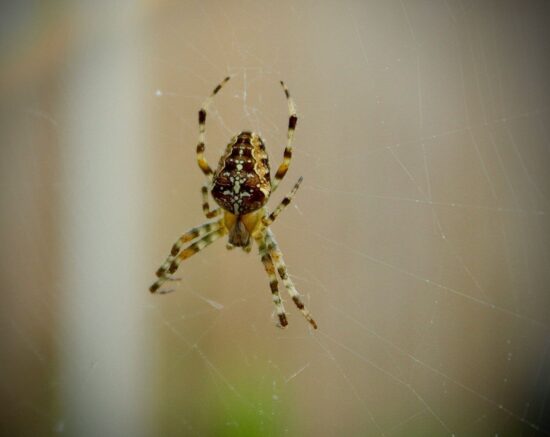Walking through your house, you might spot a spider hanging in the corner and wonder: how long has it been there, and how much longer will it stick around? With over 51,673 documented spider species worldwide, the answer to how long spiders live varies wildly depending on what type of eight-legged visitor you’re dealing with.
Some spiders live just a few months, while others can survive for decades. Let’s take a look at some of the details.
Understanding Spider Lifespans
The world of spider lifespans is full of surprises, with some species living just long enough to reproduce while others become multi-decade survivors.
The Great Lifespan Divide
Most spiders live for around two years on average, but this hides an incredible range from just a few months to over 30 years. The longest-lived spider ever recorded was a female trapdoor spider named “Number 16,” who lived an estimated 43 years from 1974 to 2016 in Australia. She could have lived even longer, but a wasp eventually killed her.
At the other end, some spiders barely make it through a single season. Garden spiders like the beautiful black and yellow Argiope aurantia only live one season, with both males and females dying when the weather becomes cold.
Gender Matters: The Male vs. Female Lifespan Gap
Female spiders can live from two to more than 25 years, generally outliving males by significant margins. Male tarantulas typically survive only one or two years after reaching sexual maturity, while female tarantulas can live 20 to 30 years or more.
Why do males die so much younger? Recent research shows that males have increased exposure to oxidative stress due to higher metabolic rates and decreased antioxidant defenses. Their more active lifestyle searching for mates creates cellular damage that shortens their lives. Some female spiders also eat the male after mating, but cellular damage is the bigger factor.
Species-Specific Lifespans
Spider lifespans vary dramatically between different types.
Common House Spiders typically live about one year, though some species like barn funnel weavers can live up to seven years. Black widow spiders live up to 3 years, while brown recluse spiders typically live 1-2 years.
Wolf Spiders show the gender gap clearly. Males live less than one year while females can live three or more years. Female wolf spiders carry their egg sacs and later carry spiderlings on their backs, helping improve baby survival rates.
Garden Spiders only live one season, putting all their energy into one big reproductive effort each year. They time their life cycle perfectly with insect availability.
Tarantulas and Mygalomorphs are the champions, living up to 25-35 years in captivity. When people ask how long spiders live, these species provide the most impressive answers. Chilean Rose Tarantulas live 15-20+ years for females and 3-10 years for males. Mexican Red Knee Tarantulas can live 25-30 years for females. These spiders molt annually even after maturity, which might help them repair damage and stay healthier longer.
The Spider Life Cycle: From Egg to Adult
Every spider goes through the same basic stages, but the details can be surprisingly different between species.
Stage 1: The Egg Phase
Female spiders construct elaborate egg sacs using layers of thick silk, creating protective cases that shield eggs from damage, temperature extremes, and predators. Egg numbers vary from 4 to 600 in a single sac, depending on species.
Hatching typically takes around 2 to 3 weeks, though temperature and humidity play huge roles. Some eggs can overwinter and hatch in spring when food is more available. Even with silk protection, parasitic wasps, flies and other insects can infiltrate egg sacs and eat the developing spiders.
Stage 2: Spiderlings – The Vulnerable Youth
Spiderlings cut holes in egg sacs with their fangs but stay inside until their first molt. They cluster together, living on remnants of yolk in their abdomens like a built-in lunch box.
When ready to leave, spiderlings use amazing travel methods. Ballooning involves releasing silk strands that catch the breeze and lift them away. Some can travel up to 30 kilometers in a single day. Bridging means climbing through foliage and swinging on silk lines to adjacent branches.
Life is tough for baby spiders. Most keepers lose 25-95% of spiderlings due to cannibalism, predation, and environmental challenges. Dispersal is necessary to avoid competition and sibling cannibalism.
Stage 3: The Molting Process
Spiders must shed their entire exoskeleton to grow, a process called molting that’s both amazing and dangerous.
Molting happens in three phases. Pre-molt: spiders stop eating, become inactive, and create protective web sacs. Active molting: blood shifts from abdomen to head, popping off the back shell, then spiders wiggle out of their old skin and pump up the new one. Post-molt: the new exoskeleton hardens over about a week while spiders remain vulnerable.
Molting is risky because spiders can get stuck and die, but it allows them to replace lost limbs. Each molt can regenerate missing legs, though it may take several molts for complete replacement.
Stage 4: Sexual Maturity and Adulthood
Most spiders reach maturity within six to eight months, though this varies by species. When spiders become adults, their priorities shift dramatically. Males become less interested in food and focus on finding mates, while females concentrate on building energy reserves for reproduction.
Factors Affecting Spider Lifespans
A spider’s lifespan depends on environmental and biological factors beyond just genetics. Understanding how long spiders live requires looking at multiple influences.
Environmental Influences
Climate and Weather: Spiders thrive in warm, humid conditions. Cold or dry environments create challenges finding food and shelter, leading to shorter lifespans. Warmer, humid environments promote longer lives due to increased prey availability.
Habitat Quality: Spiders in abundant habitats with ample prey live longer, while habitat loss due to development, deforestation, or climate change increases competition and reduces survival. Pollution can poison spiders directly or kill their prey.
Biological Factors
Genetics: Different spider families have evolved for either longevity or quick reproduction. Research on 85 tarantula species found some subfamilies consistently live longer than others.
Nutrition and Health: Studies show dietary restriction can increase spider lifespans, while overfeeding reduces them. Spiders suffer from diseases, fungal infections, mite infestations and parasitic worms that can shorten their lives.
Predation and Survival Threats
Spiders face constant dangers from birds, reptiles, mammals, and other arthropods. Birds are especially problematic due to excellent vision and opportunistic feeding. Specialized predators like hunting wasps paralyze spiders to feed their larvae.
Spiders defend themselves through camouflage (looking like bird droppings or bark), warning displays using bright colors, and escape tactics like dropping on silk lines and playing dead.
Captivity vs. Wild Lifespans
Captive spiders often live significantly longer than wild ones, showing dramatic differences in how long spiders live under different conditions. In captivity, jumping spiders may live up to 18 months compared to 6-12 months in the wild. Captive benefits include no predators, regular meals, controlled temperature and humidity, and medical care.
Wild spiders rarely reach their full potential lifespan due to predation pressure, environmental stresses like droughts and storms, and diseases that spread more easily in natural populations.
Remarkable Longevity Records
The record-holding “Number 16” trapdoor spider lived 43 years in a scientific study of 150 spider burrows. Pet tarantulas like “Rosie” the Chilean rose hair have lived nearly 25 years with proper care.
Research shows spiders in tropical, humid, low-altitude environments tend to live longer. Large range size, sub-terrestrial lifestyle, and aggressive behavior are associated with longer lifespans, while larger body size at birth correlates with shorter lives.
The Science Behind Spider Aging
Scientists are uncovering why spiders age differently. Research reveals that female spiders produce less cellular damage and have better antioxidant protection than males. Males have higher metabolic rates from being more active, leading to faster cellular damage without adequate repair systems.
Studies using data from 2,183 individual spider records help identify patterns in spider lifespan differences. Growth and molting are controlled by hormones, and understanding these systems explains why some spiders live much longer than others.
Conservation and Practical Applications
Spider experts identify agriculture, climate change, urbanization and pollution as major threats to spider species. These factors directly impact lifespans by destroying habitats and reducing prey availability.
Understanding spider life cycles helps with pest management by targeting vulnerable stages rather than broad pesticide use. For pet owners, spider lifespan information helps with planning long-term commitments, especially for species that can live decades.
Spiders play crucial ecological roles, with the global spider community killing an estimated 400-800 million metric tons of insect prey annually, making them essential for controlling pest populations.
Conclusion
Spider lifespans reveal incredible diversity in survival strategies, from garden spiders that live fast and die young to tarantulas that can outlive many pets. The range from a few months to over four decades shows how different species have evolved completely different approaches to life.
Female spiders consistently outlive males across most species, and environmental conditions like temperature, humidity, and habitat quality play crucial roles. Research continues uncovering new insights about how long spiders live, from cellular mechanisms to ecological factors affecting longevity.
Understanding spider lifespans helps us appreciate these remarkable creatures and their important ecosystem roles. Whether dealing with a house spider that might live a year or admiring a tarantula that could outlive a generation of dogs, each spider represents millions of years of evolutionary fine-tuning for survival success.


